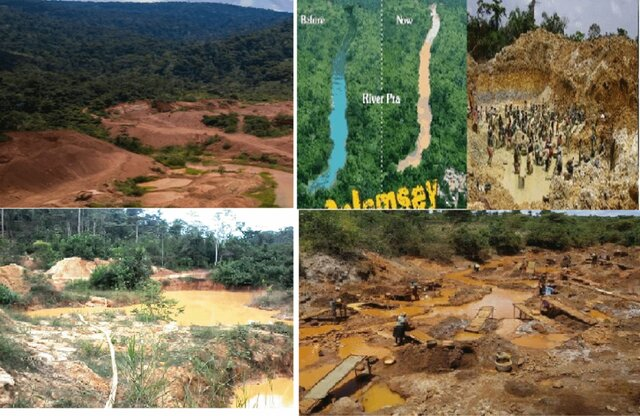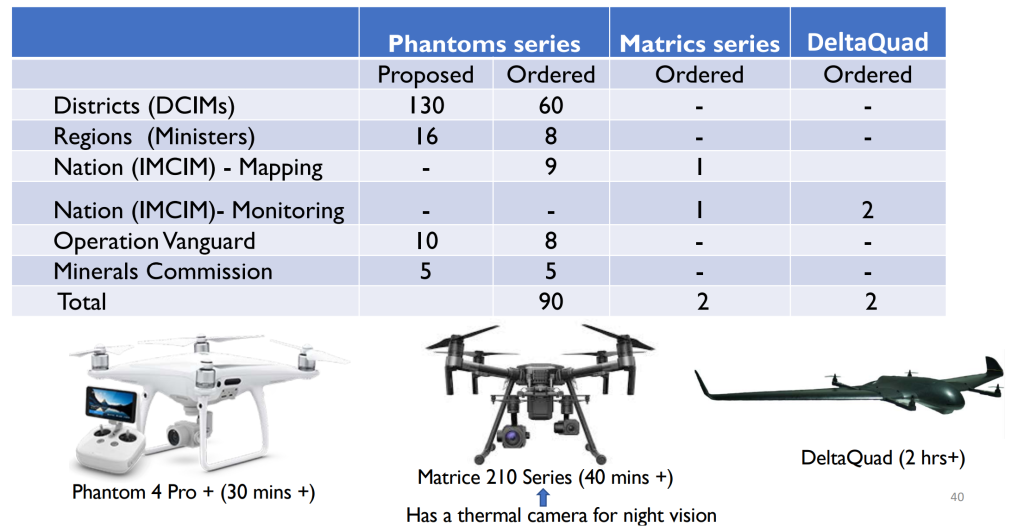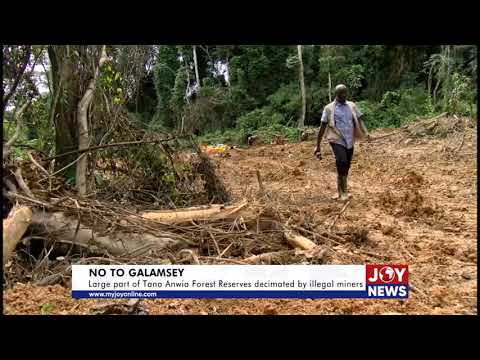The last few weeks has witnessed another mass outcry over the menace of “galamsey” in Ghana.
Galamsey is a catchall word used to describe “illegal mining”, usually for gold. Ordinarily, it should mean “mining without a license”, but in Ghana several individuals, groups, and companies purporting to have small-scale or community (artisanal) mining licenses go about their activities so irresponsibly that their effects on the environment are no different from the so-called “unlicensed” or “illegal” miners. Even some large-scale, ostensibly modern, mining companies occasionally incur the wrath of community activists like WACAM for poor pollution avoidance practices.

The end result of the chaos in Ghana’s gold sector, and some will say the true price of Ghana’s status as “Africa’s largest gold producer”, is the rampant damage being witnessed all around. Forests denuded, farmlands despoiled, and rivers turned into slimy, slurry, stinking sludge. Of all the harms irresponsible mining is causing to Ghana, it is the latter – the frightening poisoning of Ghana’s water bodies – that has really woken up the people.
Thus, when recently I took to X (formerly, Twitter) asking people to take a more holistic view about the problems afflicting Ghana’s water management, a lot of people didn’t take too kindly to my comments. I was totally out of sync, and singing out of tune, with public sentiments. Still, I am not sorry.
Galamsey Lamentations have become an elite pastime
Apart from the rather academic slant I put on my viewpoint, I was motivated by another concern: the loud lamentations about galamsey are generally pointless. The elites occasionally rouse up to tear out their hair and gnash their teeth but they never rise up in unison to demand that specific individuals, companies, and duty bearers to face the consequences of their actions. The plaintive cries about abstract evil in the face of such concrete abuses of the land and its inhabitants naturally go nowhere.
Especially given the nature of this galamsey mess. There are believed to be more than 1 million galamseyers. In many of the rural areas and small towns in which these individuals and groups operate, they have significant community support due to strong beliefs that they are engaged in gainful employment, and that this is better than “conventional crimes” like stealing and fraud. Some of these people have become important breadwinners and with that achieved the standing of objects of admiration.
Second, they have “investors” who are for the most part prominent members of society. To complicate matters further, many galamseyers look at the so-called legal, licensed, mining companies and they observe that they are doing the environment no good. Some are owned by the highest-ranking politicians in the land. With their connections, these shadow fat cats have succeeded to acquire permits to enter the country’s most ecologically sensitive sites and strip them of all life.
A Sisyphean Fight
It is no wonder then that every attempt to use the military and similar high-handed tactics inevitably end in the soldiers compromised, the fight discredited, and then abandoned. In the Rawlings era, in the late 1980s and 1990s specifically, the military appeared to be making progress, and hence created the impression that galamsey was a purely security issue. Even after the security-alone approach ultimately floundered and the succeeding government had to confront the menace all over again, the tone remained the same. Operation Flush Out. Operation Vanguard. Galamstop. Joint Task Force. And so on and so forth. Then 50,000 Chinese miners flooded the country, changfang machines made their debut, and the problem multiplied a hundred-fold.
When however seized excavators started disappearing, some military commanders started running protection rackets, and a high-profile ministerial committee imploded with the embarrassing spectacle of senior government officials accusing each other of being galamseyers, or having been corrupted by galamsey, the whole sorry show descended into the macabre, and the government quietly and unceremoniously shelved the “military raid” approach.
A different approach: policy innovation and community engagement
Along the way, acknowledgement had slowly built that a social canker so deeply rooted in communities, to an extent where the sentiments of ordinary beneficiaries of the practice diverged so much from middle-class lamenters in the cities, and hypocritical elites were the key masterminds, had to be addressed from multiple angles.
Two key additional strategies were introduced into the fight: technology and “alternative livelihoods”. Because of the government’s “digitalisation” mantra, an idea has taken root in the present government that minimising human and manual processes can temper hard situations where corruption was a major factor.
“Alternative livelihoods”, the second strategy, was in recognition of the underlying unemployment driver. Illegal mining paid more than other jobs available to most inhabitants in the areas where the menace was more concentrated. It was either a way was found to make the mining more responsible and licenses became easier to acquire or higher-productivity agricultural value chain jobs would have to be created to absorb the hundreds of thousands engaged in the despicable galamsey practice.
One reductionist interpretation of the joint effect of these two strategies was to: a) hand over chemical-free and gravity-based concentrators to boost extraction of the gold so that small and artisanal miners wouldn’t need to use mercury and install “changfangs” on riverbeds, whilst b) monitoring all these operations using drones and remote observatories all over the country. Drones and centrifuge-concentrators, in short.
State Enchantment
In my public policy research, analysis, and activism work in Ghana, I have settled on a model for analysing how “innovative solutions” interact with “self interest” among senior policymakers and high-ranking politicians. In the current political culture, nearly every single policy has to be twisted into a profit-making gig. In fact, many policymakers start from the profit motive and then design and execute policies to feed it. To avoid scrutiny, they frame the policy context in a manner likely to excite the Ghanaian sense of nationhood.
They tap into the average Ghanaian’s sense of greatness and goodness, her desire to see true prosperity and improvement in her lifetime. The political bosses proceed to hack a certain socially enforced yearning for positivity that has filled so many churches and festival grounds for eons. Then they cook up schemes primarily geared towards making easy money, add plenty garnishing of “glory and grandeur”, and loudly trumpet the benefits so much so that anyone who looks too closely and ask hard questions will be branded negative, cynical, and unpatriotic. It is often such that the mere launch of the thing being used for the enchantment is success and achievement. I call this approach, “State Enchantment”.
Inspired by a brilliant piece of journalism by the Fourth Estate in recent times, one brimming with specificity and eschewing the abstractness of elite lamentations, I have put together a short case study for you, dear readers. Here is how state enchantment is manifesting concretely in the case of galamsey.
Drones
In 2017, the government of Ghana embarked on a drone-buying spree. The first consignment was valued at $3 million. Quizzed about the high cost, the Minister in charge touted the fantastic attributes of the devices: they would be able to fly 8.2 km above sea level. This is essentially the altitude (vertical flying distance) that the largest, most sophisticated, airplanes typically fly (for perspective, recreational drones max out at about 0.1km). In fact, 8.2km is more than half the cruising altitude of an F-16 jet-fighter.
Even more revealingly, the claimed attitude of the Ghanaian anti-galamsey drones was three times the maximum level of law-enforcement drones in the United States. The specifications provided by the Minister essentially takes us into predator-drone territory, a system not available commercially. And, yet, when talking about the spatial resolution of these high-powered contraptions, the Minister suggested a performance that will make an operator of a US E-2 Hawkeye blush.
I am sure the reader has predicted the climax of this story already. The drones have never been fully accounted for. According to the Ministerial Taskforce, the specific drones acquired and their specifications are below.

Essentially, phantom 4 pro drones that cost barely $1200 each (at retail level). Maximum speed: 45 MPH. Maximum altitude? Wait for it: 0.5 km! And even that requires special configuration. The normal, out of the box, altitude is 0.125 km and the maximum control range (farthest horizontal distance it can travel) is about 7km. Essentially paper tigers. The idea of “1 drone per district”, given these specs, making any dent on galamsey was obviously fanciful from the outset. More frightening is how the country should have paid anything more than $150,000 in a bulk purchase for these devices. Yet, here was a Minister defending the use of $3 million for two hundred units of the machine.
But it doesn’t end there. The control room equipment and surveillance software were never fully deployed. In fact, based on our discreet enquiries in the security services, we can confidently say that the drones and their supporting control room infrastructure and software were not even properly commissioned and no one can provide a detailed inventory or even an account of where they are now.
The World Bank makes an appearance
Imagine my shock then when upon recently reviewing the World Bank-funded Ghana Landscape Restoration and Small-Scale Mining Project (GLRSSMP), which was approved in 2021 but formally operationalised in 2022, in part to address the galamsey problem, I saw yet more drones! Yes, the government has taken more loans from the Bretton Woods institution to buy more monitoring drones, and another set fitted with magnetometers. This time, each drone is meant to cost about $25,000. Obviously, if any serious political economy analysis had been conducted, no new drones would have been approved until a proper public enquiry had been conducted.
Centrifuges
The problems identified in the drone program pale in comparison with what our review of the centrifuge-enabled gravity concentrators turned up. As the reader may recall, these were to be provided to small scale miners to draw them away from mercury-based and changfang-style extraction approach towards towards more environmentally sustainable methods. On top of that, the machines are designed to help small scale miners enhance their recovery of gold by 300% compared to their current crude methods. In technical terms, the “gravity recovery rate” of gold from the crushed ore when using such novel concentrators is above 90%.
There are four main brands of this system on the world market. Ghana opted for the “gold kacha” platform. The $10 million was to deliver 100 units of gold kacha machines to small scale miners. The retail price was disclosed by the Minister responsible for mining as $113,000. Given the high cost of these machines, the decision was made to provide them on a leasing or hire-purchase basis to the lucky first cohort of miners.
To crown this amazing beauty of a policy, government ministers were at pains to reveal that the machine had been invented by a Ghanaian company. Through the support of the government and the Ghanaian gold industry, the pioneering success of this initiative was assured of spreading to every corner of the globe where gold is found. Viva Ghana!
I am sorry to say, even though the reader won’t be much surprised, that none of these “facts” hold up to scrutiny.
First, the “gold kacha” technology was not invented in Ghana or by a Ghanaian company or innovator. It was invented as far back as 2005 by a South African company called Appropriate Process Technologies based out of Johannesburg.
Second, it does not cost $113,000. It does not even cost $11,300. A few years ago, it sold for $1500. It is the cheapest of the 4 main competing gravity concentrator brands. Today, APT quotes the technology at ~$2175. Chinese copycat brands can even go as low as $990.
Third, the gold kacha on its own is not enough to equip a small scale miner to shift completely away from current methods. There are auxiliary items like the shaker. APT would normally sell that to you for almost $10,000 but you can get a perfectly functional one for $5000.
How these machines were priced at $113,000 per unit and handed over to miners to “work and pay” is a total mystery that only the Egyptian god of the higher mysteries, Thoth, can crack.

Even if the governments had added shakers, smelters, and backup power to the gold kacha concentrators to create a full-blown deep field mining unit, the total cost of each such package should not have exceeded $25,000.
Obviously, due to the ridiculous pricing, and the failure to provide the full set of auxiliary equipment, many miners, according to the auditor-general, have defaulted in paying, saddling the country with millions in dollars of bad debt. The Minerals Commission that supervised this mess says the government now intends to write off the debts by providing a retrospective subsidy.
In short, GOVERNANCE is the missing piece
It has been baffling observing the pressure being mounted on the government to “fix galamsey” by elite complainants. These lamenters know as well as anyone that the factors that have made the problem intractable are the same ones that civil society activists have been campaigning about for years, in respect of so many other issues. Factors like “state enchantment” and the total lack of accountability for the performance outcomes of government initiatives.
How can the Ghanaian government somehow isolate galamsey and then using the same underlying culture, logic, and motivations within the public sector “fix it” to the satisfaction of these elites?
Credit: Bright Simons/THE SCARAB
Latest Stories
-
Center for Learning and Childhood Development Director Dr Kwame Sakyi honoured at Ghana Philanthropy Awards
3 hours -
Asantehene receives 28 looted artefacts
4 hours -
CAF WCL 2024: Ghana’s Thelma Baffour wins title with TP Mazembe
5 hours -
Benjamin Boakye slams politicisation of energy sector issues and ECG’s inefficiencies
5 hours -
Erastus Asare Donkor and Dr Neta Parsram win big at 10th Mining Industry Awards
5 hours -
Government is “suppressing information” about power sector challenges – IES Director
5 hours -
Majority of our debts caused by forex shortfall – ECG Boss
5 hours -
Pan-African Savings and Loans supports Ghana Blind Union with boreholes
6 hours -
Bole-Bamboi MP Yussif Sulemana donates to artisans and Bole SHS
6 hours -
Top up your credit to avoid potential disruption – ECG to Nuri meter customers
6 hours -
Dutch & Co wins 2024 Entrepreneur of the Year Award
7 hours -
We’ll cut down imports and boost consumption of local rice and other products – Mahama
9 hours -
Prof Opoku-Agyemang donates to Tamale orphanage to mark her birthday
10 hours -
Don’t call re-painted old schools brand new infrastructure – Prof Opoku-Agyemang tells gov’t
11 hours -
Sunon Asogli plant will be back on stream in a few weeks – ECG
11 hours

